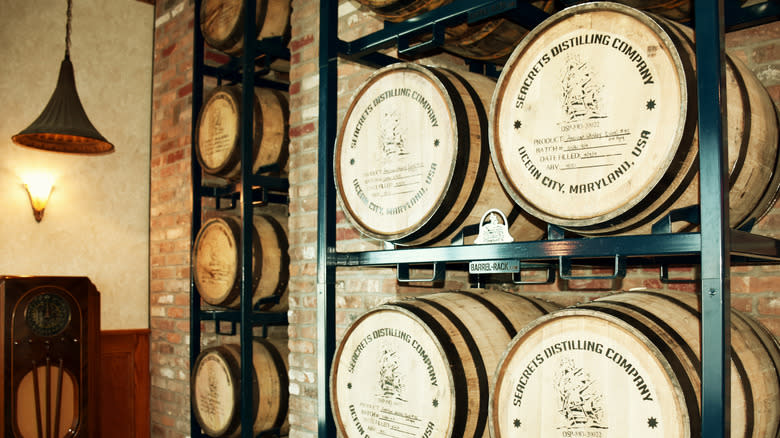The Mysterious Origins Of Maryland Rye Whiskey

No spirit is intertwined with the U.S. quite like whiskey. The tasty brown liquor spans the country's history, appearing in early formative events like the Whiskey Rebellion, which allowed Kentucky's bourbon industry to thrive. In fact, even George Washington was involved in the distilling industry, producing barrels of rye whiskey on the recommendation of his Scottish plantation manager.
Bourbon is often the more renowned American option, but rye whiskey is a product with equally deep roots. Although there are some differences between bourbon and rye whiskey, the latter follows a similar distillation procedure to its corn-based counterpart. It also takes different mash bills, but by federal mandate, these must be at least 51% rye. The rest of the ingredients are variable, as are the distillation techniques and aging process -- as long as it's in a new charred-oak barrel. Especially prior to Prohibition, this led to a large range of regional styles, with one of the most prominent being Maryland.
Until 1920, the state was one of the largest rye whiskey producers in the U.S. It had a style that accumulated over several centuries, known for its smoothness and fruitier notes. Most suspect its mash bill was heavy on the rye but also involved corn and a third grain like wheat. Unfortunately, many of the whiskey's specifics have disappeared into history, with the industry never quite recovering after the federal ban on drinking. Thankfully, it's experiencing a recent resurgence, and whiskey drinkers are uncovering its special qualities once more.
Read more: The 27 Best Bourbon Brands, Ranked
Maryland Rye Whiskey Was A Once Popular Style That Nearly Disappeared

Whiskey production in the U.S. started along the shores of the Chesapeake Bay, making the area that's now Maryland among the earliest sites of distillation. Rye was planted in the area early on, its hardy nature well suited to the conditions. Distillation soon ensued, with corn -- a beloved crop of early settlers -- added to the mix. Due to its early Catholic history, Maryland attracted many Irish immigrants, who brought along the practice of triple-distilling. This technique led to the crafting of a whiskey with smooth character, a shared quality that makes Irish whiskey the best for beginners.
Such influences combined to make a distinct Maryland style. The liquor increased in popularity during the mid-19th century as stationed Civil War troops took a liking to the style. The whiskey's sweeter, easier-drinking quality was advertised right up to Prohibition. However, after the pause on production was over, many of the distilleries were sold and worsened in quality. Especially after World War II, Kentucky became the center of whiskey-making, and much of Maryland rye's production intricacies faded into obscurity. Today, it's still debated what factors contributed to the style, with some even suggesting flavored additives, brewer's yeast, and varying mash bills.
Nevertheless, in the last decade, distillers in both Maryland and other states have taken on the task of resurrecting the style. They attempt to deconstruct the spirit's special qualities based on available information and bottle modern renditions. So, turn to producers with liquors bearing the Maryland label to try an estimated historic distillation.
Read the original article on Tasting Table

 Yahoo Lifestyle
Yahoo Lifestyle 
